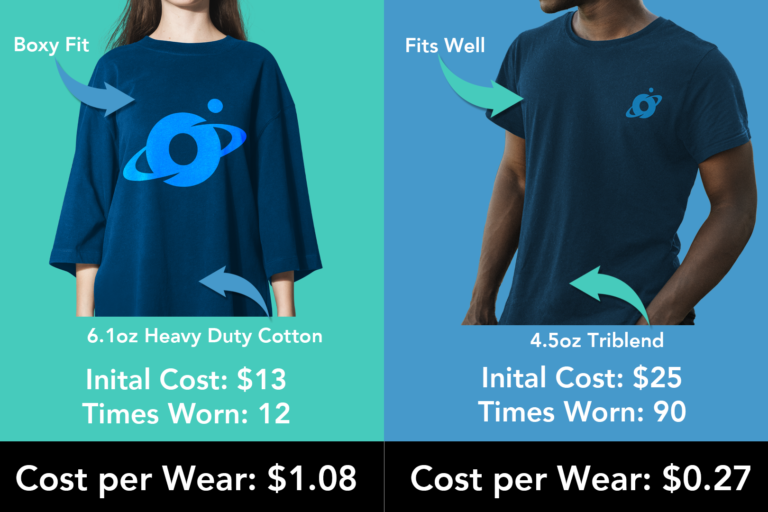Cost per wear is the concept that the more a garment is worn the better value it is over time. Cost per wear is a great way to ensure that people are engaging with your brand and that you get the most out of company swag.
Cost per wear is the concept that the more a garment is worn the better value it is over time. Cost per wear is a great way to ensure that people are engaging with your brand and that you get the most out of company swag.
So rather than giving your employees the same boxy t-shirt for every promotional drop, consider how letting employees choose their new favorite shirt can reduce costs and boost employee engagement.
What is cost per wear?
The best way to explain cost per wear is with the story of the boxy, heavy-duty cotton t-shirt.
Imagine you received an oversized, cheaply printed, and boxy-fitting t-shirt at your work’s annual barbeque. Wearing this shirt is like wearing a thin blanket that goes to your knees, and has a head hole the size of a basketball.
You might wear this shirt for the day, maybe use it for some lawn care, but after about 10 or so washes the logo is faded and the fabric is even more stretched out than before, so you throw it away.
Now, let’s assume that the shirt cost your company $13 and you wore it 12 times. That would mean its cost per wear would be $1.08. Now imagine that same barbeque, but instead you receive a nice tri-blend shirt.
You like the way it fits, and like the people you work for, so you decide to wear it a lot. It slowly became your new favorite shirt. You laugh in it, you cry in it and share many good memories with this shirt.
After wearing it 90 times, the logo has begun to fade, and the fabric is worn. You decide it is time to retire your favorite shirt, and after a few tears, it ends up being thrown away.
The initial cost for that shirt was $25 and it was worn 90 times, so the cost per wear was about 27 cents, much lower than the boxy t-shirt, but it had far more utility than just the initial cost divided by the times it was worn.

Why should you care?
A company shirt is only as useful as how much it gets worn. A shirt, or any type of apparel, that gets worn 4 or 5 times might be seen by a handful of people.
But a shirt that is worn 50, 60 or over 100 times can be seen by potential thousands. And a shirt that is worn a lot is well-loved, creating a more positive experience with it, and the brand represented on it.
Giving employees a chance to choose the clothes that they will love makes it easier for them to engage with your brand. And good brand engagement can lead to a better understanding of the company’s mission and purpose.
The subtle reminder of who you work for, and what they stand for, each time an employee wears your gear will go a long way. That mentality will bleed into their everyday lives and paint your brand in a positive light.
A nice fitting and comfortable shirt can turn your employees into brand ambassadors. And even though the initial cost will be more than a cheaply made t-shirt, the cost of its lifetime will be lower.
You will need to give less than you did before. There won’t be a need to flood your company every quarter with a fresh shirt, because they will still have, and be wearing, the ones from last time. And if they are better quality upfront, they will still look just as good.
It may seem less intuitive to spend more on apparel, and it ends up costing less, but it is true. Now, the question remains, how do you give someone their new favorite shirt?

How AXOMO can help
The primary difference between AXOMO and other swag ordering systems is the ability to let employees choose their items.
With an AXOMO store you can choose from thousands of branded items that can be loaded onto a company store, already proofed and set up with your own branding.
Employees can then be given credit to use on this store. With this method, employees can choose what they want, instead of being given something that may otherwise be thrown away.
And our research shows that people that choose their gear are up to 20 times more likely to keep it.
We work hard to make sure that many of our items can be ordered as one-offs and shipped directly to the employees, giving them even more options and chances to find their new favorite shirt!



